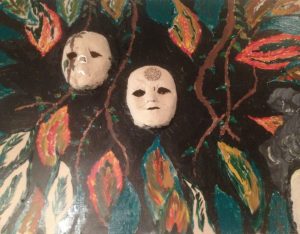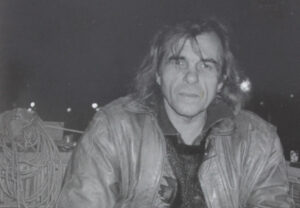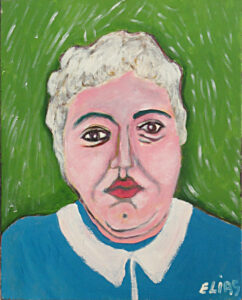Creating Art
It is hard to say when the Art Group began at PARC. Some would tell you that people have always created art in the place going back to its earliest days. Others would say that an art group started around 2002 and that Charmaine Frado was the first art instructor. Regardless of when it began, evidence of the prolific PARC art group can be found along nearly every wall in the building. A gallery of paintings runs along the offices on the second floor, down the stairs into the drop-in, covering any available space. If a visitor came by on a Tuesday evening they would find the Art Group, individuals and clusters of people working quietly at tables spread out around the large room.
Moving between the tables is Vladimir Prochazka the art instructor. Each week, Vladimir offers a different lesson, putting an demonstration piece on an easel at the centre of the room, but just as often Vladimir helps people follow their own artistic direction. PARC staff person Jessica Bonney moves quickly through the room, preparing snacks, responding to questions and ensuring that the evening runs smoothly. Jessica enjoys the culture of support that has been created in the group over the years. “I like the way people connect,” she said. “People are open to each other’s different styles of art. Every one has their own thing that is unique to them. It’s nice to be surprised, to discover people’s skills and abilities and learn what people are able to do.”

PARC member Chevy’s art omits themes of negativity and self-doubt. “Painting takes me away from my problems in my life,” she said, pointing to an acrylic painting she had been working on for three months. “These faces”, Chevy said, referring to masks featured in the painting, “mean a lot to me. I’ve left a lot behind” she added. “Art is healing” she told me. “Sometimes a painting turns out differently than the way it was in my head. In that way, it is like problems, they can take on a different shape once you start to work through them. You can look at a problem on a canvas and it turns out that it isn’t as big as it seems.”
With characteristic enthusiasm, Alice Rogers describes the therapeutic aspects of art-making: “When you do a really nice work of art, it makes you feel good. It’s great to do something you don’t think you can do.”
For Chevy, painting is a way of leaving your mark in the world. “These paintings are a way that other people can see what was a part of you at one time.” Pointing to the walls, she says, “There’s paintings on the walls of PARC by people that died, that members see everyday. They may be been gone for years, but the painting is still there for people to remember them by.”
For Ann Smart, painting helped her to literally find her voice. “About thirteen years ago, I had thyroid cancer and had to have surgery,” she explained. “Because of the surgery, I could not talk for months. A few days after I had surgery, there was an art group at PARC that I took part in. I was so depressed and art was the only thing I could do. Art kept me going for four months when I had no voice.”
“The first painting I did was a farmhouse and I made houses for many, many years. Then I started to paint ladies,” Ann continued. “Without art, it would be really depressing. Painting is my life. Every spare moment I think of art. I will never stop painting. I’m not a big talker, but painting talks for me.”
For PARC art instructor Vladimir, the variety in the artists’ motivations, backgrounds and approaches are the essence of the group. “There is so much genuineness in the art, that you could not find anywhere else, in mainstream circles, for example. The artworks reach deep into people’s hearts and spirits and bring everyone together.”
Jerry Naumyk and Art at PARC

Jerry Naumyk, a prolific illustrator and musician, was a resident at PARC until his death in 2004. With his feet planted on the ground and his eyes on the stars, Naumyk brought together the everyday with the supernatural. He illustrates popular images of uncommon things – In drawing upon myths and images from many cultural perspectives, Naumyk creates a world with many entry points. – Sean Frey
Even though Naumyk was such a prolific artist, as his huge body of work bears witness to, he was never recognized by the art world. This is a common experience as many creative people never call themselves an artist, show their work in a gallery or are accepted as an important part of the cultural canon. Naumyk’s life and work are a testament to the everyday unseen creativity that is hidden within each community. – Sean Frey

